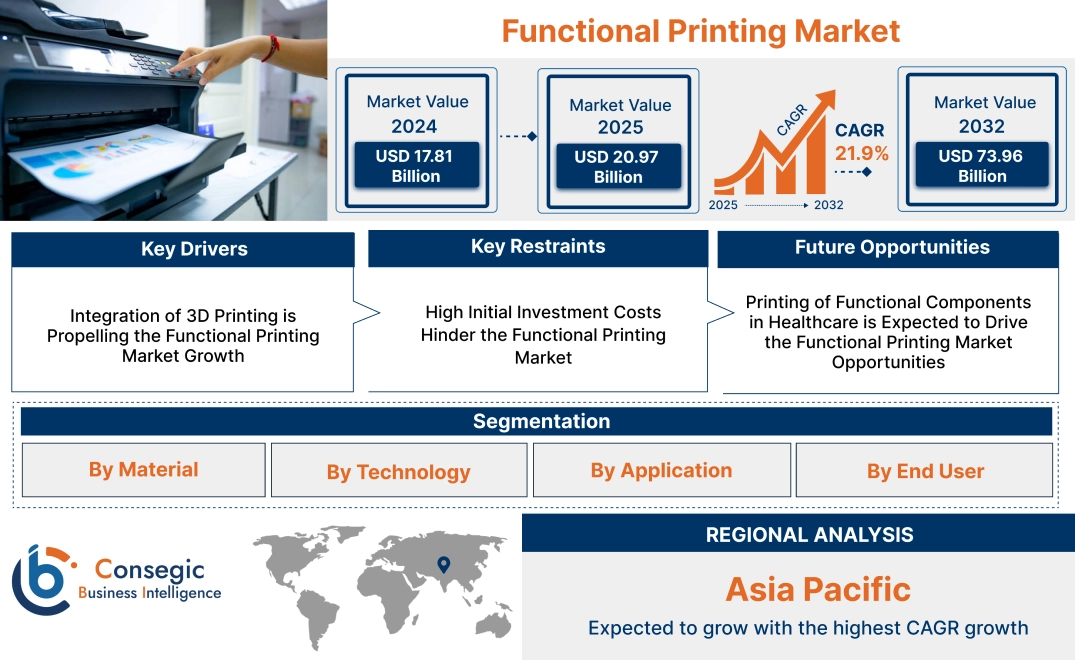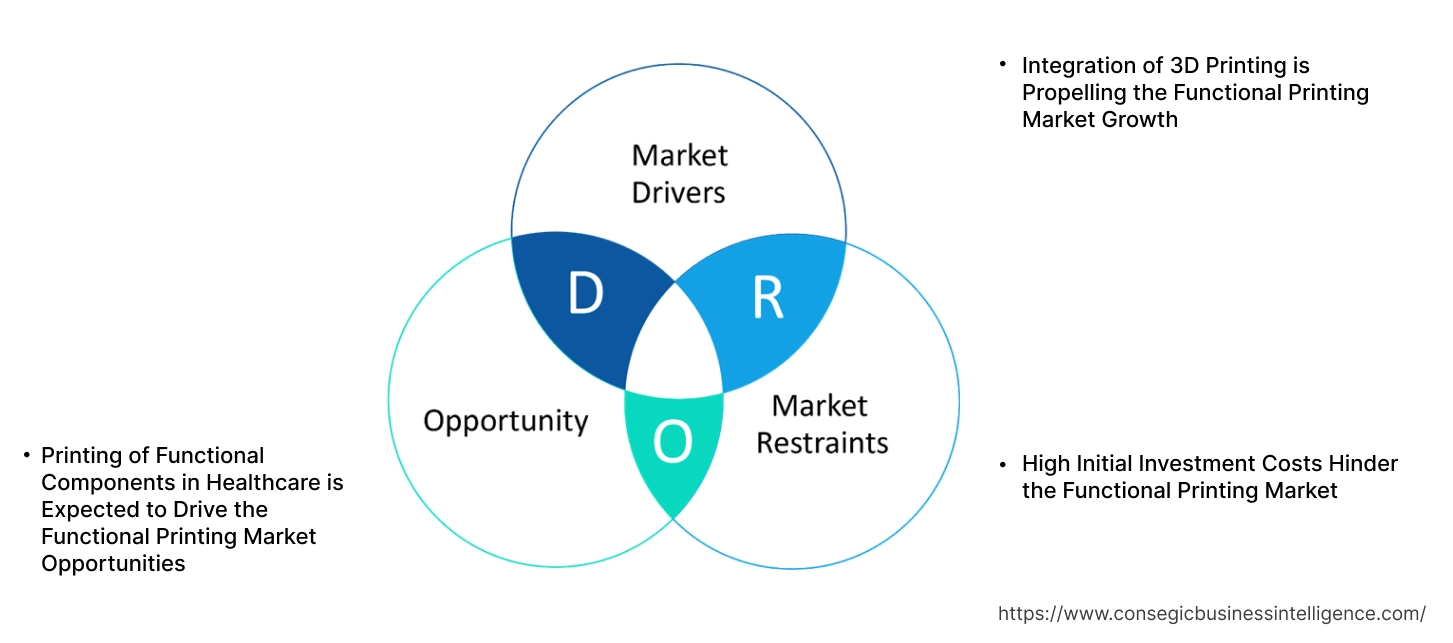- Summary
- Table Of Content
- Methodology
Functional Printing Market Size:
Functional Printing Market size is estimated to reach over USD 73.96 Billion by 2032 from a value of USD 17.81 Billion in 2024 and is projected to grow by USD 20.97 Billion in 2025, growing at a CAGR of 21.9% from 2025 to 2032.
Functional Printing Market Scope & Overview:
Functional printing refers to the process of using a printer to print parts or objects that provide a function in a product. It encompasses a variety of techniques using special printing processes to print structures whose dimensions can be 2D or 3D. Printing of functional components experienced growth due to the increasing need for manufacturers to save material costs and reduce environmental damage that can result from excess materials used in traditional manufacturing processes. Further, growing use of printing to print electrical components or circuits and sensors has resulted in the development of the overall market.
Key Drivers:
Integration of 3D Printing is Propelling the Functional Printing Market Growth
Printers used for printing functional components in manufacturing have experienced technological advancement due to integration of 3D. Many manufacturers today use 3D printing to make functional parts that are used as a component in a whole part or product. Further, 3D printers used for printing functional components offer many advantages including less raw materials used for printing compared to traditional manufacturing and rapid prototyping of custom functional parts.
- For instance, Nscrypt offers 3D printing solutions that can be used to print functional components like Printed Circuit Boards (PCB).
Hence, the increasing use of 3D printers used for functional component printing is driving the market.
Key Restraints:
High Initial Investment Costs Hinder the Functional Printing Market
Printing of functional components often requires specialized printers that come with high initial investment costs, affecting the functional printing market demand as investment costs can get really high for certain printers. Additional costs may also be incurred for maintenance and upgrading of the software used for the printers. The implementation of such printers can be complex as the technology used in the printers requires a certain level of training and understanding of the inks and statures to effectively utilize the technology. The initial training cost can be quite high due to the complexity of the printers which hinder the market. Thus, the high initial investment costs associated with the functional printers are restraining the market growth.
Future Opportunities :
Printing of Functional Components in Healthcare is Expected to Drive the Functional Printing Market Opportunities
Many companies today have started using functional printers to print wearable sensors for use in healthcare. The sensors can include temperature monitor sensors or patches which are used for physiotherapy. The patches can be placed near the nerves where the patient is experiencing pain to stimulate the nerve cells. The production of sensors or patches using functional printing has resulted in adoption of functional sensors, driving the market.
- For instance, Enfucell offers a wearable temperature tag that uses a printed paper battery for energy. The tag is used to record the temperature of the user at different time intervals.
Thus, rising technological advancements in printing of functional components for healthcare are projected to drive the functional printing market opportunities during the forecast period.
Functional Printing Market Segmental Analysis :
By Material:
Based on the material, the market is segmented substrates and inks.
Trends in the material:
- Increasing adoption of metal substrates for use in automotive and manufacturing industries drives the market.
- Rising utilization of conductive inks that are electrically conductive for manufacturing of electronic products.
Substrates accounted for the largest revenue share in the market in 2024.
- The application of images, text, and designs onto printing substrates forms the basis of printing. This increasing use of substrates in creating robust components is a key factor in the functional printing market expansion.
- Factors like thickness and texture of the substrate can vary depending on the use case, like polyethylene terephthalate or polyethylene naphthalate. The various substrates available for different components has resulted in the market growth.
- For instance, Kodak uses Polyethylene Terephthalate (PET) substrate for the printing of electronic components like antennas, circuit boards, and sensors.
- Thus, increasing advancements associated with substrates are driving the functional printing market.
Inks is anticipated to register the fastest growing CAGR during the forecast period.
- Different inks are used for different components like conductive inks are used in sensors and circuit boards because the ink can conduct electricity in the printed object which is driving the functional printing market demand
- There has been an increase in the use of dielectric inks for the manufacturing of touchscreens which are used in electronic devices.
- For instance, Henkel offers non-conductive dielectric ink for use in printed electronics like biosensors and flexible circuits.
- Thus, the growing ink segment is driving the functional printing market expansion during the forecast period.
By Technology:
Based on the technology, the market is segmented into inkjet printing, offset printing, gravure printing, screen printing, and others.
Trends in the technology:
- Rising adoption of screen printing for printing of functional components like displays and PCBs drives the market.
- Quicker printing processes and the ability to utilize materials with diverse viscosities are propelling the growth of the market.
Screen Printing accounted for the largest revenue share in the year 2024 and is anticipated to register the fastest growing CAGR during the forecast period.
- Screen Printing has witnessed growth due to the fact the process and materials used during development and production phase can be the same which can help in scaling the production process.
- Screen printing also offers a wide range of material viscosities which results in printing components that can have thicker layers. The ability to print thicker layers can be useful for certain components that require robustness like circuit boards.
- Moreover, market growth is being propelled by the increasing number of companies offering screen printers for high-volume electronics production.
- For instance, HMI printers offers fully automated screen printing systems for faster and precise setup, which can be used for the production of consumer electronics
- Therefore, as per the analysis, the screen printing segment has witnessed growing usage during the forecast period driving functional printing market.
By Application:
Based on the application, the market is segmented into sensors, displays, screen, antennas, RFID tags, and others.
Trends in the Application:
- Increasing use of functional printers for RFID tags for use in smart parking systems and asset management in warehouses drives the market.
- Factors including growing investments in printers used for printing screens for smartphones are driving the market trends.
RFID tags accounted for the largest revenue share in the market in 2024.
- RFID tags have experienced a growing need as many businesses today are moving to smart packaging for their products.
- There has been a growing demand for printers that support adaptive encoding technology that helps in selecting the optimum encode settings.
- Many printers used for functional printing support wireless connectivity for remote handling and real time visibility of the printers allowing for better management of the devices.
- For instance, Zebra offers printers that can be used for RFID tag printing such as ZT600 RFID industrial printer series that can be used for many applications like inventory management and asset tracking.
- Therefore, the increasing use of functional printers for RFID tags is driving the functional printing market growth.
Sensors is anticipated to register the fastest CAGR during the forecast period.
- Sensors form the backbone of Internet of Things and are used for monitoring different information like temperature and motion.
- Many businesses today offer printing solutions for functional sensors that can be used in cars, healthcare devices, and production phase of different products, driving the functional printing market trends.
- For instance, Quad industries offers printing solutions like simulation, design and manufacturing of sensors through its production plant for printed sensors and other wearable or flexible electronics.
- Thus, as per the analysis, the rising adoption of sensors has resulted in growing demand for printers, in turn, propelling the functional printing market size during the forecast period.
By End User:
Based on the end user, the market is segmented into automotive, healthcare, electronics, and others.
Trends in the end user:
- Increasing adoption of functional printers for printing of components in electronics segment like touchscreens, NFC chips, and displays drives the functional printing market size.
- There is a rising trend towards utilization of functional printers for healthcare monitoring, heart and brain monitoring, and physiotherapy using electrical signals released from printed components.
Electronics accounted for the largest revenue share of 34.12% in the year 2024.
- The dominance of electronics is attributed to the growing smartphones and wearable devices market that use printed functional electronic components.
- Growing use of different types of substrates to print displays that offer better graphic contrast which can be used in smartphones and computers.
- Moreover, many companies today printing OLED lightings and touch panels using techniques like flexographic printing and gravure printing, which has increased the functional printing market share.
- For instance, KYMC offers printing solutions like flexographic printing using different substrates to print OLED lightings, touch panels, and displays.
- Thus, as per the functional printing market analysis the growing electronics segment is driving the overall functional printing market trends.
Healthcare is anticipated to register the fastest CAGR during the forecast period.
- Hospitals and clinics have started using printed electronic sensors and other components for monitoring key health information like temperature of the patient in turn driving the overall functional printing market share.
- Printed biosensors have experienced a growing demand for various uses including tracking the electrical activity of a patient’s heart through ECG sensors.
- For instance, Henkel offers a printed patch that collects vital signs from a patient when attached to the body and sends the data to the cloud for remote healthcare monitoring.
- Thus, as per the analysis, the increasing use of functional printer solutions in healthcare for monitoring of health information through sensors and patches is driving the functional printing industry.
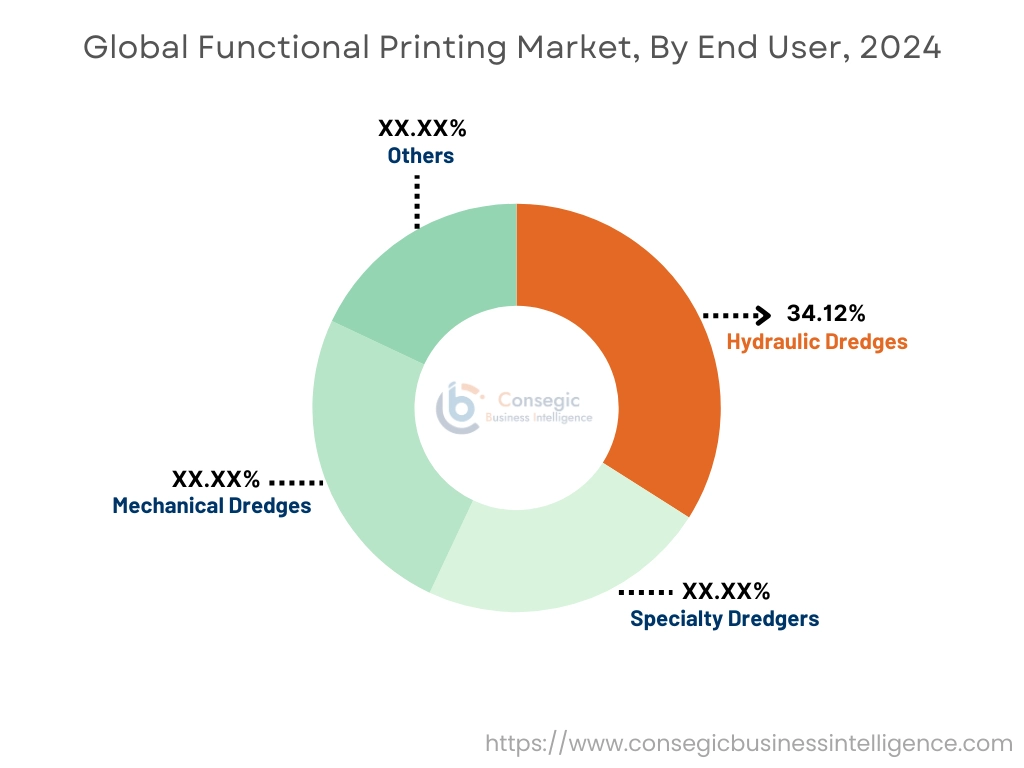
Regional Analysis:
The regions covered are North America, Europe, Asia Pacific, the Middle East and Africa, and Latin America.
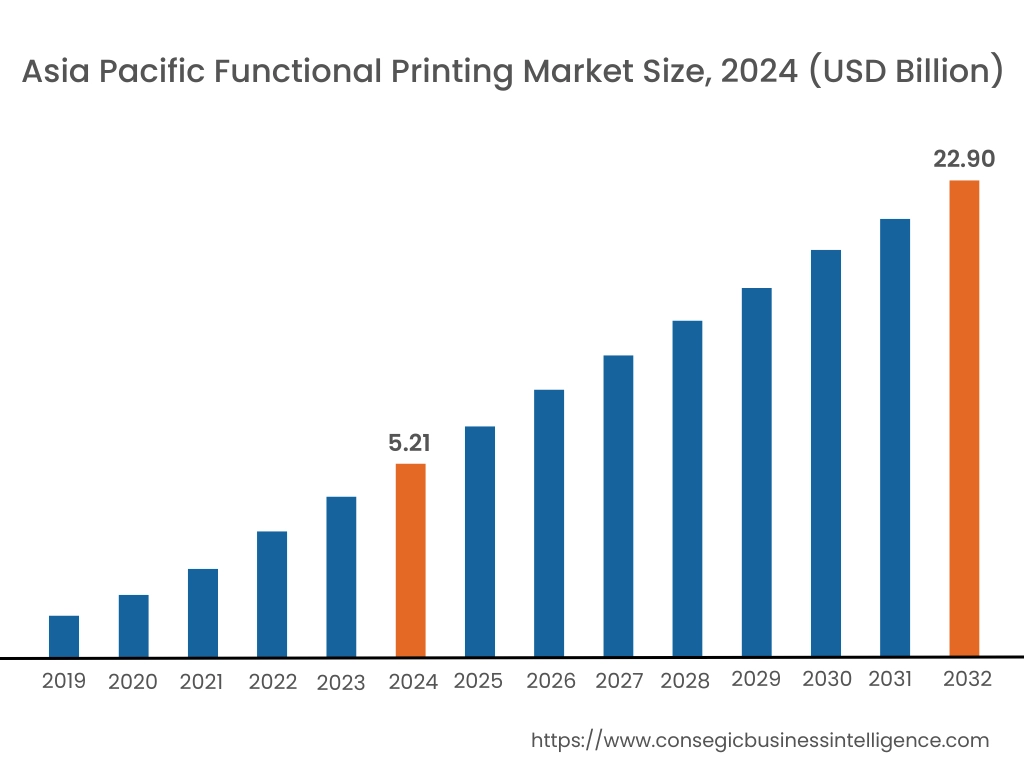
Asia Pacific region was valued at USD 5.21 Billion in 2024. Moreover, it is projected to grow by USD 6.16 Billion in 2025 and reach over USD 22.90 Billion by 2032. Out of this, China accounted for the maximum revenue share of 36.78%. As per the functional printing market analysis, the adoption of functional printers in the Asia-Pacific region is primarily driven by the growing investments in healthcare, manufacturing and electronics segment among others.
- In June 2023, Celanese announced the launch of Micromax LF series conductive inks for printed electronics industry. Micromax Electronic Inks and Paste is a leading brand in printed electronics industry for inks used in the functional printing process.
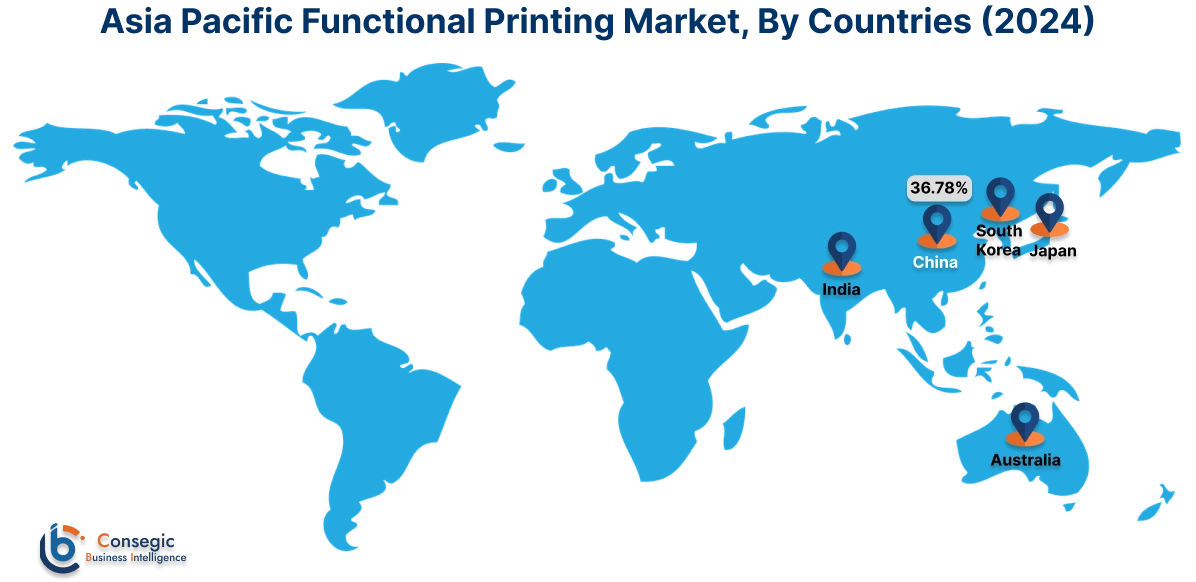
North America is estimated to reach over USD 22.94 Billion by 2032 from a value of USD 5.62 Billion in 2024 and is projected to grow by USD 6.61 Billion in 2025. In North America, the development of the market is driven by the growing investments in retail, e-commerce, and healthcare. Moreover, many companies today offer printing solutions for retail packaging in North America driving the regional development.
- For instance, Zebra offers RFID labels and packaging printers that are used in retail sectors like fragrance, cosmetics, beauty products, which shows the growing demand for RFID label printing for retail packaging.
Additionally, the regional study depicts that the growing healthcare sector and growing investments by companies for use of printed electronics and other components in automotive is driving market demand in Europe. Furthermore, as per the market analysis, the market in Latin America is expected to grow at a considerable rate due to many factors including the growing use of sensors for supply chain tracking supply, and growing need for electrical patches in healthcare. The Middle East and African region is expected to grow at a considerable rate due to factors like growing use of printed components for use in wearable electronics and increase in functional components uses in manufacturing.
Top Key Players and Market Share Insights:
The global functional printing market report suggests the market is highly competitive with major players providing solutions to the national and international markets. Key players are adopting several strategies in research and development (R&D), product innovation, and end-user launches to hold a strong position in market. Key players in the functional printing industry include-
- Eastman Kodak Company (U.S.)
- Zebra Technologies Corporation (U.S.)
- Henkel AG & Co. (Germany)
- Altana Group (Germany)
- AGFA-Gevaert Group (Belgium)
- Tapecon Inc. (U.S.)
- BASF (Germany)
- Mark Andy Inc. (U.S.)
- Rotimpres (Spain)
- Toyo Ink Co. Ltd. (Japan)
Recent Industry Developments :
Product Launch:
- In January 2025, Kodak announced the launch of a new version 11.0 of Kodak Prinerygy software introducing various features including improved usability for Virtual Proofing Software (VPS) and other functional and performance improvement. Prinergy is a software solution that provides integrated and future-proof workflow automation for digital and analog printing processes.
- In May 2024, Boston Micro Fabrication announced the launch of a line of hybrid printing solutions using a technique that allows for rapid photopolymerization. The feature allows the user the option to choose either 25µmor 10µm resolution depending on the geometry of the part being printed.
Functional Printing Market Report Insights:
| Report Attributes | Report Details |
| Study Timeline | 2019-2032 |
| Market Size in 2032 | USD 73.96 Billion |
| CAGR (2025-2032) | 21.9% |
| By Material |
|
| By Technology |
|
| By Application |
|
| By End User |
|
| By Region |
|
| Key Players |
|
| North America | U.S. Canada Mexico |
| Europe | U.K. Germany France Spain Italy Russia Benelux Rest of Europe |
| APAC | China South Korea Japan India Australia ASEAN Rest of Asia-Pacific |
| Middle East and Africa | GCC Turkey South Africa Rest of MEA |
| LATAM | Brazil Argentina Chile Rest of LATAM |
| Report Coverage |
|
Key Questions Answered in the Report
How big is the functional printing market? +
The functional printing market is estimated to reach over USD 73.96 Billion by 2032 from a value of USD 17.81 Billion in 2024 and is projected to grow by USD 20.97 Billion in 2025, growing at a CAGR of 21.9% from 2025 to 2032.
Which is the fastest-growing region in the functional printing market? +
Asia-Pacific region is experiencing the most rapid growth in the functional printing market.
What specific segmentation details are covered in the functional printing market report? +
The functional printing market report includes specific segmentation details for material, technology, application, end user, and regions.
Who are the major players in the functional printing market? +
The key participants in functional printing market are Eastman Kodak Company (U.S.), Zebra Technologies Corporation (U.S.), Tapecon Inc. (U.S.), BASF (Germany), Mark Andy Inc. (U.S.), Rotimpres (Spain), Toyo Ink Co. Ltd. (Japan), Henkel AG & Co. (Germany), Altana Group (Germany), AGFA-Gevaert Group (Belgium), and others.
